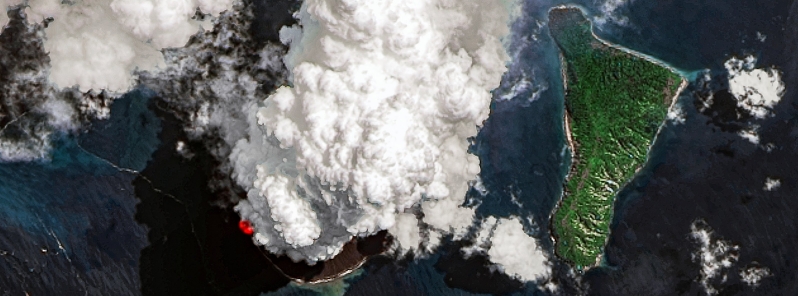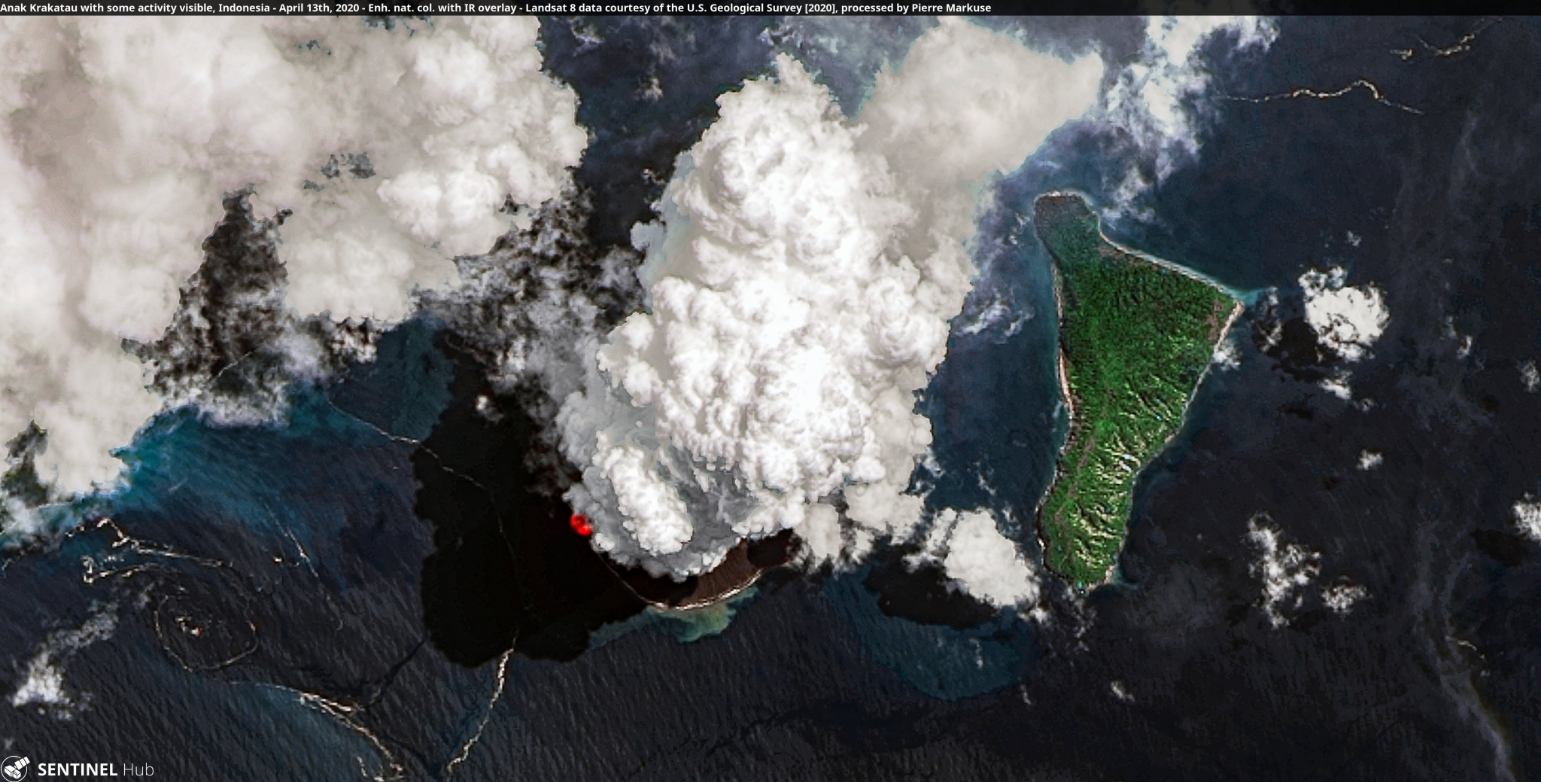Another strong explosion at Anak Krakatau, Indonesia

Another strong eruption occurred at Indonesia's Anak Krakatau volcano on April 13, 2020, three days after a powerful magmatic eruption when the volcano spewed volcanic ash up to 14.3 km (47 000 feet) above sea level. As of Wednesday, April 14, the Aviation Color Code remains Orange.
The volcano, located in Sunda Strait, West Sumatra, is emitting gas and steam, possibly small explosions too as it remains active. It also shows an almost constant glow at night.
On Tuesday, April 13, a strong explosion occurred at around 13:54 UTC (20:54 LT). The eruption was recorded on a seismogram with a maximum amplitude of 40 mm and duration 54 seconds.

Notice the infrared signature. Image credit: USGS/Landsat-8, Pierre Markuse, Acquired on April 13, 2020.
This was likely a Vulcanian-type event– a type of volcanic eruption characterized by a dense cloud of ash-packed gas blowing up from the crater and rising high above the peak, Dr. Tom Pfeiffer of Volcano Discovery noted.
Incandescent lava bombs landed on Anak Krakatau's outer slope.

On April 10, the volcano began erupting at 14:58 UTC (21:58 LT), with thick white-gray volcanic ash about 200 m (650 feet) high from the bottom of the crater. It was recorded on a seismogram with a maximum amplitude of 40 mm, lasting for 72 seconds.


Anak Krakatau or Child of Krakatau emerged in 1927 from the caldera that formed after massive VEI 6 Krakatau eruption of 1883 — one of the biggest in recorded history. The eruption started on May 20 and lasted at least to October 21, causing more than 36 000 fatalities, most as a result of devastating tsunamis that swept the adjacent coastlines of Sumatra and Java.
The activity intensified as the volcano entered its paroxysmal phase around late August, and then by August 26, a black cloud of ash was seen as high as 27 km (88 000 feet). Four big explosions followed on August 27.
According to the GVP, pyroclastic surges traveled 40 km (25 miles) across the Sunda Strait and reached the Sumatra coast. The caldera collapse during the catastrophic 1883 eruption destroyed Danan and Perbuwatan and left only a remnant of Rakata.
A year following the eruption, the average summer temperatures in the Northern Hemisphere dropped by 0.4 °C (0.72 °F).
The eruption injected an unusually large amount of sulfur dioxide (SO2) gas high into the stratosphere, which was subsequently transported by high-level winds all over the planet.
This led to a global increase in sulfuric acid (H2SO4) concentration in high-level cirrus clouds. The resulting increase in cloud reflectivity (or albedo) reflected more incoming light from the Sun than usual and cooled the entire planet until the sulfur fell to the ground as acid precipitation.
Skies were darkened across the world for years after the explosion, producing spectacular sunsets for months. The Moon reportedly appeared green and blue at times.
After a quiescence of less than a half-century, the post-collapse cone of Anak Krakatau was constructed within the 1883 caldera at a point between the former cones of Danan and Perbuwatan. Frequent eruptions were reported at the volcano since 1927 (VEI 1 to 3).
Geological summary
The renowned volcano Krakatau (frequently misstated as Krakatoa) lies in the Sunda Strait between Java and Sumatra. The collapse of the ancestral Krakatau edifice, perhaps in 416 CE, formed a 7-km-wide (4.3 miles) caldera.
Remnants of this ancestral volcano are preserved in Verlaten and Lang Islands; subsequently Rakata, Danan and Perbuwatan volcanoes were formed, coalescing to create the pre-1883 Krakatau Island. Caldera collapse during the catastrophic 1883 eruption destroyed Danan and Perbuwatan volcanoes and left only a remnant of Rakata volcano.
This eruption, the 2nd largest in Indonesia during historical time, caused more than 36 000 fatalities, most as a result of devastating tsunamis that swept the adjacent coastlines of Sumatra and Java. Pyroclastic surges traveled 40 km (25 miles) across the Sunda Strait and reached the Sumatra coast.
After a quiescence of less than a half-century, the post-collapse cone of Anak Krakatau (Child of Krakatau) was constructed within the 1883 caldera at a point between the former cones of Danan and Perbuwatan. Anak Krakatau has been the site of frequent eruptions since 1927. (GVP)
Featured image credit: USGS/Landsat-8, Pierre Markuse, Acquired on April 13, 2020.

Even the full eruption of many volcanoes like Anak Krakatau, or an engineered virus that spreads globally are nothing in comparison to the eruption of Yellowstone Super-volcano, which will take place-with absolute certainty- this year 2020. The American government should make disaster planning to save lives